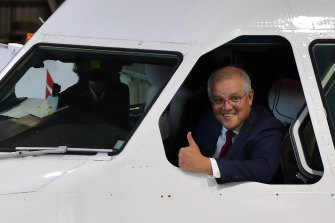Almost a year to the day after it introduced the JobKeeper wage subsidy, the Morrison government will turn the financial tap off on March 28. As a means of keeping people in employment during the worst of the pandemic, the scheme has been successful.
There are now fewer than one million people on the subsidy, but a disproportionate number of those are in tourism-related areas such as aviation. It is no secret why. There has been a drop of 41 million domestic passenger airline flights over the past 12 months, with tourist operators hardest hit by rolling state border closures and the lack of international visitors.
Prime Minister Scott Morrison leaning out of a Qantas plane on Thursday ahead of announcing the $1.2 billion industry package. Credit:Dean Lewins/AAP
So in principle, the new federal scheme that funds 800,000 domestic travellers to take half-price flights hits the mark in offering help where it is most needed. Not everyone is happy. The cheap flights to 15 airports from April to July includes just one destination in Victoria (Avalon), New South Wales, and Western Australia, two in South Australia and the Northern Territory but five in Queensland and three in Tasmania.
The question has to be asked why the federal government is subsidising Victorians to fly to Queensland for their winter break?
For many tourist operators in regional Victoria, it must be a blow that their operations will suffer as a result of Melburnians being encouraged to head to the far north or possibly south to Tasmania, instead of travelling within the state.
The lack of fairness in the new system has many groups up in arms. Victorian Chamber of Commerce and Industry chief executive Paul Guerra questioned why Tasmania got the “first-class treatment” of three airports compared with Victoria’s one. “As good as coming into Avalon is … it doesn’t help the CBD, it doesn’t help the Mornington Peninsula, it doesn’t help East Gippsland,” he said.
There is certainly the demand. On Friday, Victorians snapped up all 40,000 Melbourne travel vouchers worth $200 offered by the state government in less than five minutes. For the city’s hotels, which are reportedly experiencing occupancy rates as low as 10 per cent, this would be a much-needed boon.
The is also concern that giving people half-price air tickets is primarily a subsidy for the airlines rather than the broader tourism industry. Qantas’ share price jumped on the announcement, although it is true that if someone flies to a destination, then they spend money on food and accommodation.
The federal government has said it will widen the list of destinations once the scheme gets up and running. There is no question that more help is needed.
While it’s hoped that the rollout of the vaccine will make it harder for premiers to shut borders when another outbreak occurs, the federal government acknowledged this week that the vaccination program was running behind schedule and may not finish up until early next year.
When the JobKeeper subsidy was introduced, its central purpose was to keep businesses afloat during the pandemic. For most sectors, the worst is hopefully behind them. But for much of the tourism sector, they are still struggling to find a way back.
It will come. Once the pandemic is contained, there is sure to be pent-up demand for travel after having to stay so close to home for so long. But unless the Morrison government takes a more expansive approach to helping the industry once JobKeeper has expired, many may fail to get to the other side.
Note from the Editor
The Age’s editor, Gay Alcorn, writes an exclusive newsletter for subscribers on the week’s most important stories and issues. Sign up here to receive it every Friday.
Most Viewed in Politics
From our partners
Source: Read Full Article








